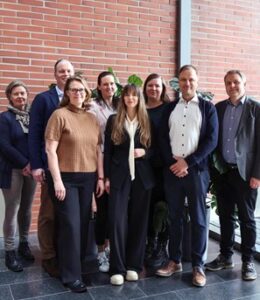-
Services
-
On behalf of Laine IP, I would like to thank all our customers for their trust in us during 2024. I would also like to thank our staff for a great year. Below are some highlights from this rewarding year:
We had the pleasure of welcoming European Patent Attorney Torsti Härkönen (electronics), patent engineer Pia Lindblom (biochemistry) and patent attorney Christoffer Karlsson (chemistry). In December, we were joined by Jari Hovinen, European Patent Attorney, and Tarja Lantto, IP Coordinator. The US team welcomed US patent attorney trainee Adam Herrala Bricker.
In the spring, we received great news: our trademark practice received the Trademark Firm of the Year (Finland) award in the Managing IP Awards
After midsummer, we learned that 7 of our patent experts were recognized in the IAM 1000 guide. In addition, Laine’s experts were ranked as MIP Stars: Tatu Ahlskog and Kathy Wasström (in the patent category) as well as Joose Kilpimaa and Reijo Kokko (in the trademark category). European Patent Attorneys Tiia-Riikka Kittilä and Joni Vehmas, as well as EU Trade Mark and Design Attorney Jemina Koskela, were recognized as Rising Stars.

One of the highlights of the year was our autumn seminar “45 years riding IPR waves”, where we were able to enjoy each other’s company, excellent presentations and Laine’s own beer in beautiful autumn weather. Thanks again to all the speakers and participants!

We also welcomed three newly qualified European Patent Attorneys; Tiia-Riikka Kittilä, Viivi Ruusila and Maria Weintraub completed this demanding examination. Heli Alasaari successfully passed the European patent administration certification (EPAC) exam in the autumn. In addition, Thomas Öhman and Adam Herrala Bricker passed the US agent exam.
During the year, the company invited six new shareholders and we moved to new, larger premises within the same building. Our financial performance was also excellent.
In view of these positive results, we will be able to continue to develop our service as well as our skills in 2025. The coming year will certainly be interesting. Thank you for being with us on our journey!

We thank all our clients for the past year and wish you a Merry Christmas and a Happy New Year 2025!
This year we made a donation to support Save the Children’s work in Finland.

Laine IP Oy team
Laine IP’s patent paralegal Heli Alasaari succeeded in passing the third edition of the European patent administration certification-examination (EPAC) earlier this autumn. The examination is rather demanding, as it is not enough to have a long experience to pass it, one also needs to study hard.
The examination has two parts, a first part with multiple choice questions and a second part with open questions. The second part is corrected only if enough points is obtained in the first part.
Also this year the exam questions were partly very tricky, concerning also situation that one encounters rarely, if ever, in the work of a patent paralegal. A further challenge comes from the time pressure, as it is necessary in a short time to present answers to situations, part of which might be such that the candidate does not have any practical experience of them. Thus, in order to be successfull in the exam, one needs not only to have experience and study, but also to have steady nerves and good stress tolerance.
The persons who have passed this Europe-wide exam can thus refer to these four letters also in order to show proof of their knowledge.
Laine IP warmly congratulates Heli of this great achievement! We are glad that your are part of our team.

The Patentee can start proceedings for infringement in a national court or the UPC. Similarly, a third party having received a request to cease alleged infringement can start proceedings in a court for a declaration of non-infringement.
In case opposition proceedings are pending at the EPO, this third party can intervene in the opposition proceedings, in certain conditions, within three months of the institution of the proceedings in a court. Intervention is also possible when the opposition proceedings are already in the second instance, i.e. an appeal is pending at the Board of Appeal.
A question on whether the intervener can continue the appeal proceedings on their own has been asked at the Enlarged Board of Appeal already previously (G3/04). In this case, the EBoA decided that if all original appellants withdraw their appeals, the appeal proceedings are terminated. The status of the intervener that joins the proceedings only at the appeal stage is thus at the moment different from that of the parties to the first instance proceedings.
The question has been referred to the EBoA again, G2/24, based on the decision T1286/23 of the technical BoA. This decision criticises the earlier decision of the EBoA, i.a. as not being aligned with the Travaux Préparatoires of the EPC1973. The questions referred are as follows.
After withdrawal of all appeals, may the proceedings be continued with a third party who intervened during the appeal proceedings? In particular, may the third party acquire an appellant status corresponding to the status of a person entitled to appeal within the meaning of Article 107, first sentence, EPC?
The technical BoA proposes in its decision T1286/23 that an intervener that files their intervention during appeal proceedings could have three different statuses depending on the situation (reasons 3.9.4). The intervener would be a respondent, if the patent was revoked in the first instance (this would require the payment of opposition fee only, as an opponent does not have a right to appeal in such a situation); the intervener would have the same status as the appellant, if they pay the appeal fee in addition to the opposition fee; or the intervener would be a party as of right if they so wish and pay the opposition fee.
Currently, there is no basis in the EPC for the payment of appeal fee in this situation and therefore, it will be interesting to see how the EBoA will view such a proposal. As an alternative to the payment of the appeal fee, the technical BoA proposes that in case all appeals are withdrawn, the case is automatically remitted to first instance (reasons 3.16.2), which would leave the possibility to appeal for the intervener, should the decision of first instance not be as desired. This seems an option that would be easier to implement, not necessitating any changes in the Implementing Regulations
Most notably, the increases to existing fees include:
US National Application base filing fees will increase from 1,660 USD to 1,810 USD (664 USD to 724 USD for Small Entities).

Base filing fees for Nonprovisional applications filed directly in the U.S. under 35 U.S.C. 111(a), including divisional or continuation applications of National Stage Applications, will increase from 1,820 USD to 2,000 USD (728 USD to 800 USD for Small Entities).

Excess claim fees will significantly increase – double for excess claims over twenty (20)! Accordingly, it is highly recommended to reduce claims to 20 total / 3 independent claims, upon filing or shortly after filing.

RCE fees will significantly increase as well, particularly for the 2nd+ RCE. Given the high cost of an RCE, an Applicant may strongly wish to consider entering the Appeal process. For comparison, the costs for entering the Appeal process (fees of which will also increase) are also listed below.

Extension fees will increase as well, rendering non-timely filed responses more costly than ever.

The fee for proceeding from allowance to issuance of a US Patent (Issue Fee) will increase slightly: $1,200 -> $1,290 (Large Entity) and $480 -> $516 (Small Entity).
Effective January 19, 2025, there are also new fees for continuing applications (continuation, divisional, or continuation-in-part applications) filed over 6 years and 9 years from the application’s earliest benefit date, as well as new fees for IDS listings with over 50 cumulative cited references. The new fees are presented below:
Of note, the earliest benefit date (EBD) cannot be the filing date of a foreign application or the filing date of a provisional application to which benefit is claimed under 35 U.S.C. 119(e).

There will be new fees, based on the total number of cited references to the USPTO in an IDS, when greater than fifty (50) references.

For more information and the specific fees, please see Federal Guidelines
If you have any questions on this article or on US patents generally, please contact a member of our US IP Team.
In our experience, acceptance into the AFCP 2.0 Program was relatively Examiner-dependent and subjective. When it worked, the AFCP 2.0 Program allowed the Applicant to make clarifying and/or “minor” substantive amendments to the claims After Final, while giving the Examiner at least some additional searching time. As such, Examiners were at least less likely to readily dismiss any substantive claim amendments (made after Final) in an Advisory Action as “requiring further search and consideration.”
The AFCP 2.0 Program is being terminated for economical reasons. According to the USPTO, the AFCP 2.0 Program has allegedly led to significant administrative costs to the USPTO, and a proposed fee structure by the USPTO aimed at offsetting said costs was met by public resistance.
The decision to terminate the AFCP 2.0 Program will likely require Applicant to even more carefully consider whether to make claim amendments after receiving a Final Office Action.
With the AFCP 2.0 Program gone, the After-Final options remain to do one or more of the following:
There are pros and cons to each of the above strategies. The best strategy, however, is to try and avoid being in a position After Final where the Examiner has not yet examined any subject matter of importance to the Applicant. This is further of increased importance given the upcoming January 2025 USPTO fee increases, which will make the Request for Continued Examination (RCE) and Extension fees more costly than ever.
To reduce the likelihood of RCE and Extension fees, we strongly recommend reviewing the Specification and corresponding foreign applications and making amendments / adding new claims as needed at various stages before receiving a Final Office Action, namely:
At Laine IP, we aim to make US patent prosecution as efficient and effective as possible, while meeting our clients’ business objectives. If you have any questions on this article or on US patents generally, please contact a member of our US IP Team.
IP STARS 2024: Laine IP Recognized in Top Tier for Patent and Trademark Excellence
We are excited to share that Laine IP has been recognized in the prestigious Tier 1 category for both patent and trademark services in the 2024 Managing Intellectual Property (MIP) rankings. This annual publication is renowned in the intellectual property realm, featuring evaluations based on comprehensive independent research involving feedback from clients and industry peers.
Achieving Tier 1 status for both our patent and trademark work highlights our commitment to our clients and their businesses. These recognitions reflect the positive experiences shared by our customers, highlighting our dedication to providing exceptional support.
MIP Stars
In addition to our firm’s recognition, several of our experts have also been acknowledged individually. Tatu Ahlskog and Kathy Wasström have received MIP Stars in the patent category, while Joose Kilpimaa and Reijo Kokko have been honored in the trademark category.




Rising Stars
Furthermore, MIP celebrates emerging talent through its Rising Star awards. We are proud to announce that our European Patent Attorneys Tiia-Riikka Kittilä and Joni Vehmas, along with EU Trademark and Design Attorney Jemina Koskela, have all been recognized as Rising Stars for their significant contributions to their clients’ successes.



We congratulate all our recognized experts on this remarkable achievement!
At Laine IP, we are proud to be counted among the world’s leading intellectual property firms once again. We would like to express our gratitude to our clients and partners for their continued trust and support. We also want to acknowledge our dedicated team, whose commitment ensures the protection of our clients’ intellectual property rights.
Thank you for being a part of our journey!
Unified Patent Court (UPC) has started its operation on June 1, 2023. The UPC system simplifies patenting in Europe such that it is possible to request for unitary effect for a granted European patent in the countries, which have ratified the Agreement on a Unified Patent Court (UPCA). A European patent with unitary effect may also be referred to as a Unitary Patent (UP).
The UPCA entered into force in Romania on 1 September 2024. It is therefore now possible to request for unitary effect for a granted European patent in 18 countries, which have ratified the UPCA.
The countries which have ratified the UPCA are at the moment (marked in the map): Austria, Belgium, Bulgaria, Denmark, Estonia, Finland, France, Germany, Italy, Latvia, Lithuania, Luxembourg, Malta, Netherlands, Portugal, Romania, Slovenia and Sweden.

We will continue to actively monitor the situation and get back to you, if there are any changes.
If you have any questions relating to the UPC, please contact our UPC experts at upc@laineip.fi
Our office will close on Friday, 30th August exceptionally at 12:00 due to relocation of our Helsinki office to the 4th floor at our current address (Porkkalankatu 24). We will re-open normally on Monday, September 2 at 8.30 AM.
Our telephone numbers work normalwise, so in urgent matters you will reach our experts by phone (office: 09 6859 560).
We apologize for any inconvenience caused.

We’re excited to announce that Dr. Adam Herrala Bricker has joined our firm as a Patent Agent Trainee in our US IP Team. Adam holds a Bachelor of Science in Physics from Michigan State University in the U.S.; Master’s Degrees in Human Neuroscience and Philosophy; and a Ph.D. in Philosophy from the University of Edinburgh.
He joins our firm after last working as a Postdoctoral Researcher at the University of Turku, having previously held postdoctoral positions at the Universities of Oulu and Cologne, as well as a visiting researcher position at Dartmouth College. Additionally, Adam is fluent in several computer programming languages, especially Python for data processing and JavaScript for web development. Adam adds to our firm’s capabilities in assisting our clients with their US IP needs.
For further information, please contact Mark Scott +358504091218 or mark.scott@laineip.fi